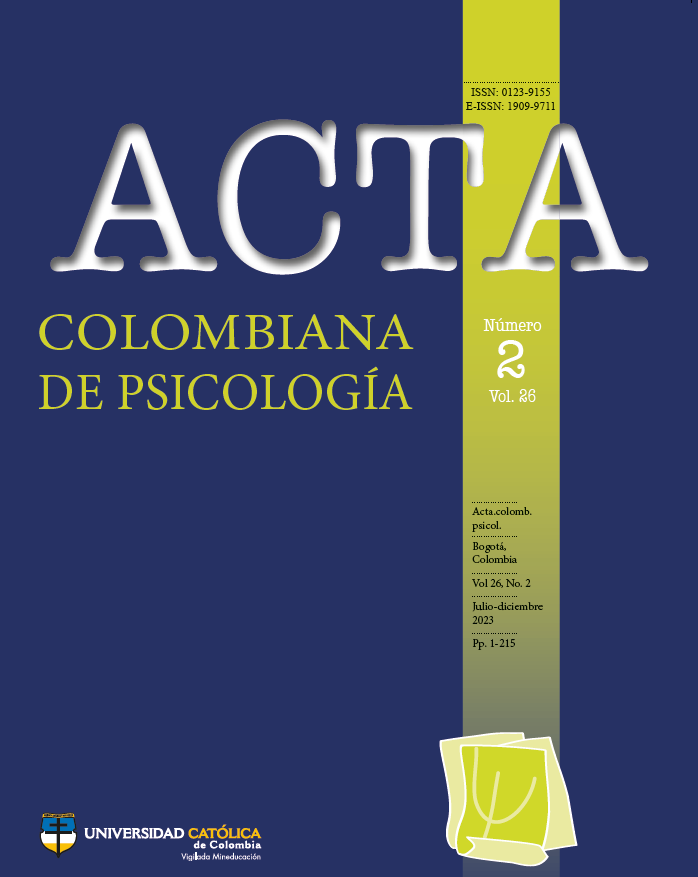
Esta obra está bajo una licencia internacional Creative Commons Atribución-NoComercial-CompartirIgual 4.0.
Los autores que publiquen en esta Revista aceptan las siguientes condiciones:
Acta Colombiana de Psicología se guía por las normas internacionales sobre propiedad intelectual y derechos de autor, y de manera particular el artículo 58 de la Constitución Política de Colombia, la Ley 23 de 1982 y el Acuerdo 172 del 30 de Septiembre de 2010 (Reglamento de propiedad intelectual de la Universidad Católica de Colombia)
Los autores conservan los derechos de autor y ceden a la Revista el derecho de la primera publicación, con el trabajo registrado con la Este obra está bajo una licencia de Creative Commons Reconocimiento-NoComercial-CompartirIgual 4.0 Internacional, que permite a terceros utilizar lo publicado siempre que mencionen la autoría del trabajo y a la primera publicación en esta Revista.
Resumen
La personalidad tipo D se refiere a la vulnerabilidad frente al estrés psicológico, la cual se expresa en dos componentes: la afectividad negativa (AN) y la inhibición social (IS), que pueden desencadenar un estado de estrés psicosocial que afecta la salud. El objetivo de este estudio fue analizar las propiedades psicométricas de la Escala de Personalidad Tipo D (DS-14) en población adulta colombiana. La muestra estuvo conformada por 456 adultos (41.7% hombres y 58.3% mujeres) colombianos entre los 18 y 86 años. El coeficiente de fiabilidad para las dos subescalas de la DS-14 fue de .73 (AN) y .72 (IS), y .79 para el puntaje total. Se analizó la validez concurrente con medidas de estrategias de afrontamiento resiliente y afrontamiento religioso. Los resultados evidencian validez interna y externa, dados los índices del análisis factorial exploratorio y confirmatorio.

Citas
Alcaraz, S., Hidalgo, M., Godoy, C., & Fernández, E. (2018). Spanish validation of the Type D Personality Scale (ds14). Behavioral Psychology / Psicología Conductual, 26(1), 195-209. https://www.proquest.com/docview/2023388492/fulltextPDF/7AAEA68CE7594A6FPQ/1?accountid=45660
Alçelik, A., Yıldırım, O., Canan, F., Eroğlu, M., Aktaş, G., & Şavl, H. (2012). A Preliminary psychometric evaluation of the type D personality construct in Turkish hemodialysis patients. Journal of Mood Disorders, 2(1), 1-5. https://www.pbsciences.org/?mno=16503
Cortina, J. M. (1993). What is coefficient alpha? An examination of theory and applications. Journal of Applied Psychology, 78(1), 98-104. https://doi. org/10.1037/0021-9010.78.1.98
Demirci, S., Demirci, K., & Demirci, S. (2017). The effect of type D personality on quality of life in patients with multiple sclerosis. Archive Neuropsychiatry, 54(3), 272-276. https://www.ncbi.nlm.nih.gov/pmc/articles/PMC5630108/
Denollet, J. (2000). Type D personality: A potential risk factor refined. Journal of Psychosomatic Research, 49(4), 255-266. https://doi.org/10.1016/s0022-3999(00)00177-x
Denollet, J. (2005). DS14: Standard assessment of negative affectivity, social inhibition, and type D personality. Psychosomatic Medicine, 67(1), 89-97. https://doi.org/10.1097/01.psy.0000149256.81953.49
Denollet, J., & Conraads, V. M. (2011). Type D personality and vulnerability to adverse outcomes in heart disease. Cleveland Clinic Journal of Medicine, 78(1), S13-S19. https://doi.org/10.3949/ccjm.78.s1.02
Denollet, J., Gidron, Y., Vrints, C. J., & Conraads, V. M. (2010). Anger, suppressed anger, and risk of adverse events in patients with coronary artery disease. The American Journal Of Cardiology, 105(11), 1555-1560. https://doi.org/10.1016/j.amjcard.2010.01.015
Denollet, J., Sys, S. U., & Brutsaert, D. L. (1995). Personality and mortality after myocardial infarction. Psychosomatic Medicine, 57(6), 582-591. https://doi.org/10.1097/00006842-199511000-00011
Díaz-Castillo, R., González-Escobar, S., González-Arratia, N. I., López-Fuentes, M. M. L. L., & Montero-López, L. (2019). Resiliencia en adultos mayores: estudio de revisión. Neurama, 6(2), 37-45. https://www.neurama.es/articulos/12/neuramavol6_2.pdf#page=37
Domínguez Lara, S. (2014). ¿Matrices policóricas/tetracóricas o matrices Pearson? Un estudio metodológico. Revista Argentina de Ciencias del Comportamiento, 6(1), 39-48. https://revistas.unc.edu.ar/index.php/racc/article/view/6357/Lara2014
El-Baz, N., Ondusova, D., Studencan, M., Rosenberger, J., Reijneveld, S., P van Dijk, J., & Middel, B. (2018). Differences between Slovak and Dutch patients scheduled for coronary artery bypass graft surgery regarding clinical and psychosocial predictors of physical and mental health-related quality of life. European Journal of Cardiovascular Nursing, 17(4), 324-335. https://doi.org/10.1177/1474515117747571
Fakhari, A., Norouzi, S., & Zakarya, M. (2014). يسسشب پيت همانشسشپ يسساف هخسن يياياپ و يياوس
.يبلق یشنوشک ناساميب سد( 14DS(D يتيصخش Medical Journal of Tabriz University of Medical Sciences
and Health Services, 36(4), 78-85. https://mj.tbzmed.ac.ir/PDF/9469.pdf
Freiberg Hoffmann, A., Stover, J., De la Iglesia, G., & Fernández Liporace, M. (2013). Correlaciones policóricas y tetracóricas en estudios factoriales exploratorios y confirmatorios. Ciencias Psicológicas, 7(2), 151-164. https://doi.org/10.22235/cp.v7i1.1057
Hernández Sampieri, R., Fernández Collado, C., & Baptista Lucio, P. (2014). Metodología de la investigación (6.a ed.). McGraw-Hill.
Hinkle, D., Wiersma, W., & Jurs, S. (2003). Applied statistics for the behavioral sciences (5.a ed.). Houghton Mifflin.
Hu, L., & Bentler, P. M. (1999). Cutoff criteria for fit indexes in covariance structure analysis: Conventional criterio versus new alternatives. Structural Equation Modeling: A Multidisciplinary Journal, 6(1), 1-55. https://doi.org/10.1080/10705519909540118
Kaur, S., Zuraida, N., Yun, W., Ramasamy, R., & Singh, J. (2014). Factor structure of type D scale in Malaysian patients with coronary artery disease. asean Journal of Psychiatry, 15(2), 186-195. https://www.aseanjournalofpsychiatry.org/articles/factor-structure-of-type-d-scale-in-malaysian-patients-with-coronary-artery-disease.pdf
Kupper, N., & Denollet, J. (2014). Type D personality is associated with social anxiety in the general population. International Journal Behavioral Medicine, 21(3), 496-505. https://doi:10.1007/s12529-013-9350-x
Ley 1090 de 2006. (Septiembre 6). Por la cual se reglamenta el ejercicio de la profesión de Psicología, se dicta el Código Deontológico y Bioético y otras disposiciones. 6 de septiembre de 2003. D.O.: 46.383. https://www.funcionpublica.gov.co/eva/gestornormativo/norma. php?i=66205
Ley 1164 de 2007. Por la cual se dictan disposiciones en materia del Talento Humano en Salud. 3 de octubre de 2007. D.O.: 46.771. https://www.minsalud.gov.co/Normatividad_Nuevo/LEY%201164%20DE%202007.pdf
Lim, J., Lee, M., Ko, Y., Park, Y., Joe, S., Kim, Y., Han, Ch., Lee, H., Pedersen, S., & Denollet, J. (2011). Assessment of the Type D personality construct in the Korean population: A validation study of the Korean DS14. Journal of Korean Medical Science, 26(1), 116-123. https://doi.org/10.3346/jkms.2011.26.1.116
Lloret-Segura, S., Ferreres-Traver, A., Hernández-Baeza, A., & Tomás-Marco, I. (2014). El análisis factorial exploratorio de los ítems: una guía práctica, revisada y actualizada. Anales de Psicología, 30(3), 1151-1169. http://dx.doi.org/10.6018/analesps.30.3.199361
Lord, F. M., Novick, M. R., & Birnbaum, A. (1968). Statistical theories of mental test scores. Addison-Wesley.
McDonald, R. (1999). Test Theory: A unified treatment (1.a ed.). Lawrence Erlbaum Associates.
Mezzadra, J., & Simkin, H. (2017). Validación de la escala abreviada de afrontamiento religioso Brief-rcope en el contexto argentino en estudiantes de confesión católica. Revista Evaluar, 17(1), 18-28. https://doi.org/10.35670/1667-4545.v17.n1.17071
Ministerio de Salud de Colombia. (1993, 4 de octubre). Resolución 8430 de 1993, Por la cual se establecen las normas científicas, técnicas y administrativas para la investigación en salud. https://www.minsalud.gov. co/sites/rid/Lists/BibliotecaDigital/RIDE/DE/DIJ/RESOLUCION-8430-DE-1993.PDF
Mols, F., & Denollet, J. (2010). Type D personality in the general population: A systematic review of health status, mechanisms of disease, and work-related problems. Health and Quality of Life Outcomes, 8, Artículo 9. https://doi.org/10.1186/1477-7525-8-9
Montero, P., Bermúdez, J., & Rueda, B. (2017). Adaptación al castellano de la Escala ds-14 («Type D Scale-14») para la medida de la personalidad tipo D. Revista de Psicopatología y Psicología Clínica, 22(1), 55-67. https://www.aepcp.net/wp-content/uploads/2020/04/Revista-de-Psicopatologia-y-Psicologia-Clinica_Vol.221.2017_Parte9.pdf
Montero, I., & León, O. (2002). Clasificación y descripción de las metodologías de investigación en psicología. Revista Internacional de Psicología Clínica y de la Salud, 2(3), 503-508. https://aepc.es/ijchp/articulos_pdf/ijchp-53.pdf
Moret-Tatay, C., Fernández-Muñoz, J. J., Civera-Mollá, C., Navarro-Pardo, E., & Alcover-de-la-Hera, C. (2015). Psychometric properties and Factor structure of the brcs in an elderly Spanish sample. Anales De Psicología, 31(3), 1030-1034. https://doi.org/10.6018/analesps.31.3.188401
Nunnally, J. C. (1978). Psychometric theory (2.aed.). McGraw-Hill.
Ogińska-Bulik, N., & Juczyński, Z. (2009). Type D personality in Poland: Validity and application of the polish DS14. Polish Psychological Bulletin, 40(3), 130-136. https://doi:10.2478/s10059-009-0029-8
Pargament, K., Koenig, H., & Pérez, L. (2000). The many methods of religious coping: Development and initial validation of the rcope. Journal of Clinical Psychology, 56(4), 519-543. https://doi.org/10.1002/(SICI)1097-4679(200004)56:4%3C519::AID-JCLP6%3E3.0.CO;2-1
Pargament, K., Smith, B., Koenig, H., & Perez, L. (1998). Patterns of positive and negative religious coping with major life stressors. Journal for the Scientific Study of Religion, 37(4), 710-724. https://doi.org/10.2307/1388152
Pargament, K., Murray-Swank, N., Magyar, G., & Ano, G. (2005). Spiritual Struggle: A phenomenon of interest to psychology and religion. In W. R. Miller & H. D.Delaney (Eds.), Judeo-Christian perspectives on psychology: Human nature, motivation, and change (pp.245-268). American Psychological Association. https://doi.org/10.1037/10859-013
Pedersen, S. S., & Denollet, J. (2006). Is type D personality here to stay? Emerging evidence across cardiovascular disease patients groups. Current Cardiology Reviews, 2(3), 205-213. https://doi.org/10.2174/157340306778019441
Pedersen, S. S., Herrmann-Lingen, C., De Jonge, P., & Scherer, M. (2010). Type D personality is a predictor of poor emotional quality of life in primary care heart failure patients independent of depressive symptoms and New York Heart Association functional class. Journal of Behavioral Medicine, 33, 72-80. https://doi:10.1007/s10865-009-9236-1
R Core Team. (2019). R: A language and environment for statistical computing. R Foundation for Statistical Computing. https://www.R-project.org/.
Reyes-Rodríguez, M., Cujiño-Medrano, M., Cano- Santana, D., Orozco-Barragán, S., Pereira-Morales, Á., & Díaz-Trujillo, M. (2020). Afrontamiento y viudez en la vejez: estudio mixto en población colombiana. Interdisciplinaria, 37(1), 113-127. https://doi.org/10.16888/interd.2020.37.1.7
Rivera-Ledesma, A., & Montero -López Lena, M. (2014). Ajuste psicológico y vida religiosa en adultos mayores. Universitas Psychologica, 13(3), 15-26. https://doi.org/10.11144/Javeriana.UPSY13-3.apvr
Sinclair, V. G., & Wallston, K. A. (2004). The development and psychometric evaluation of the Brief Resilient Coping Scale. Assessment, 11(1), 94-101. https://doi.org/10.1177/1073191103258144
Simkin, H. (2017). Psicología de la religión: adaptación y validación de escalas de evaluación psicológica en el contexto argentino. Anuario de Investigaciones, XXIV, 177-185. https://www.psi.uba.ar/investigaciones/revistas/anuario/trabajos_completos/24/simkin.pdf
Soriano, J., & Monsalve, V. (2019). Perfiles de personalidad y resiliencia en dolor crónico: utilidad del cdrisc-10 para discriminar los tipos resiliente y vulnerable. Revista de la Sociedad Española del Dolor, 26(2), 72-80. https://doi.org/10.20986/resed.2018.3670/2018
Spindler, S., Kruse, Ch., Zwisler, A., & Pedersen, S. (2009). Increased anxiety and depression in Danish cardiac patients with a type D personality: Cross-validation of the type D Scale (DS14). International Journal Behavioral Medicine, 16(2), 98-107. https://doi:10.1007/s12529-009-9037-5
Stroputea, D., Bunevicius, A., Staniute, M., Brozaitiene, J., & Bunevicius, R. (2015). Type D (distressed) personality in Lithuanian patients with coronary artery disease: A
dataset. Biomedical Data Journal, 1(2), 26-30. http://dx.doi.org/10.11610/bmdj.01205
Tulloch, H., & Pelletier, R. (2008). Does personality matter after all? Type D personality and its implications for cardiovascular prevention and rehabilitation. Current Issues in Cardiac Rehabilitation and Prevention, 16, 1-4.
Trizano-Hermosilla, I., & Alvarado, J. M. (2016). Best alternatives to Cronbach’s alpha reliability in realistic conditions: Congeneric and asymmetrical measurements. Frontiers in Psychology, 7, Artículo 769. https://doi.ogr/10.3389/fpsyg.2016.00769
Trucco, M. (2002). Estrés y trastornos mentales: aspectos neurobiológicos y psicosociales. Revista Chilena de Neuro-Psiquiatría, 40(2), 8-19. http://dx.doi.org/10.4067/S0717-92272002000600002
Vukovic, O., Lecic, D., Jasovic-Gasic, M., Damjanovic, D., Zebic, M., Britvic, D., Stepanovic, J., Djordjevic-Dikic, J., Beleslin, B., & Ostojic, M. (2014). Type personality in patients with coronary artery desease. Psychiatria Danubina, 26(1), 46-51. https://www.psychiatriadanubina.com/UserDocsImages/pdf/dnb_vol26_no1/dnb_vol26_no1_46.pdf
Welch, S., & Comer, J. (1988). Quantitative methods for public administration: Techniques and applications. Editorial Books; Cole Publishing.
Weng, Ch., Denollet, J., Lin, Ch., Lin, T., Wang, W., Lin, J., Wong, Sh., & Mols, F. (2013). The validity of the Type D construct and its assessment in Taiwan. bmc Biomed Central Psychiatry, 13(46), 1-9. http://www.biomedcentral.com/1471-244X/13/46
Yang, Y., & Green, S. B. (2011). Coefficient Alpha: A reliability coefficient for the 21st Century? Journal of Psychoeducational, 29(4), 377-392. https://doi:10.1177/0734282911406668
Yu, C. Y. (2002). Evaluating cutoff criteria of model fit indices for latent variable models with binary and continuous outcomes. [Tesis doctoral, University of California]. http://www.statmodel.com/download/Yudissertation.pdf.
Zohar, J. (2016). Is type-D personality trait(s) or state? An examination of type-D temporal stability in older Israeli adults in the community. PeerJ Journals, (4), Artículo e1690. https://doi.org/10.7717/peerj.1690


































